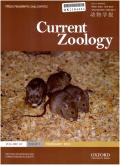Trophic niche segregation in a guild of top predators within the Mediterranean Basin
IF 2
2区 生物学
Q2 ZOOLOGY
引用次数: 0
Abstract
Niche theory predicts that closely related and ecologically similar species with overlapping distribution ranges can coexist through resource partitioning, that limits interspecific competition. However, studies examining the mechanisms promoting coexistence of top predators at a large geographical scale are still scant. Here, we describe the foraging ecology of three sympatric owl species [Northern long-eared owl (Asio otus), Tawny owl (Strix aluco), Eurasian eagle owl (Bubo bubo)] in the Mediterranean Basin. We review 160 studies reporting diet information (212,236 vertebrate preys) and investigate among-species differences in diet metrics (diversity, evenness, prey size and proportion of mammals) and their variation along geographical and environmental gradients. Moreover, we test whether diet metrics differ in presence or absence of the other predators. All the three species mainly rely on small mammals, but they significantly differ in diet metrics. The smallest predator (i.e., long-eared owl) shows a higher level of specialism on small mammals (highest proportion but lowest diversity of mammals in the diet) compared to the larger ones. In addition, mean prey size significantly increases with predator body size (long-eared owl < tawny owl < eagle owl). Finally, interspecific competition results in an increase of diet diversity and evenness in the long-eared owl, and species’ diet also varies in response to environmental factors. The three species thus segregate along several dietary niche axes over a large spatial scale and according to both morphological characteristics (i.e., body size) and environmental variables. Such dietary niche segregation may adaptively buffer interspecific competition costs, ultimately allowing coexistence.地中海盆地顶级掠食者协会的营养位隔离
根据生态位理论的预测,分布范围重叠、关系密切、生态相似的物种可以通过资源分配共存,从而限制种间竞争。然而,在大地理范围内研究促进顶级捕食者共存机制的研究仍然很少。在这里,我们描述了地中海盆地三种同栖猫头鹰物种(北长耳鸮、黄喉鸮、欧亚鹰鸮)的觅食生态学。我们回顾了报告食谱信息的 160 项研究(212,236 种脊椎动物猎物),并调查了食谱指标(多样性、均匀度、猎物大小和哺乳动物比例)的物种间差异及其在地理和环境梯度上的变化。此外,我们还测试了在有或没有其他捕食者的情况下,食性指标是否有所不同。这三个物种都主要以小型哺乳动物为食,但它们的食性指标有显著差异。与体型较大的捕食者相比,体型最小的捕食者(即长耳鸮)对小型哺乳动物的专一程度更高(食物中哺乳动物的比例最高,但多样性最低)。此外,猎物的平均大小随捕食者的体型(长耳鸮< 灰褐鸮< 鹰头鸮)而明显增大。最后,种间竞争导致长耳鸮的食性多样性和均匀性增加,物种的食性也随环境因素而变化。因此,这三个物种根据形态特征(即体型)和环境变量,在较大的空间范围内沿着几个食性生态位轴进行分离。这种食物生态位隔离可能会适应性地缓冲种间竞争成本,最终实现共存。
本文章由计算机程序翻译,如有差异,请以英文原文为准。
求助全文
约1分钟内获得全文
求助全文
来源期刊

Current Zoology
Agricultural and Biological Sciences-Animal Science and Zoology
CiteScore
3.20
自引率
9.10%
发文量
111
审稿时长
6 weeks
期刊介绍:
About the Journal
Current Zoology (formerly Acta Zoologica Sinica, founded in 1935) is an open access, bimonthly, peer-reviewed international journal of zoology. It publishes review articles and research papers in the fields of ecology, evolution and behaviour.
Current Zoology is sponsored by Institute of Zoology, Chinese Academy of Sciences, along with the China Zoological Society.
 求助内容:
求助内容: 应助结果提醒方式:
应助结果提醒方式:


